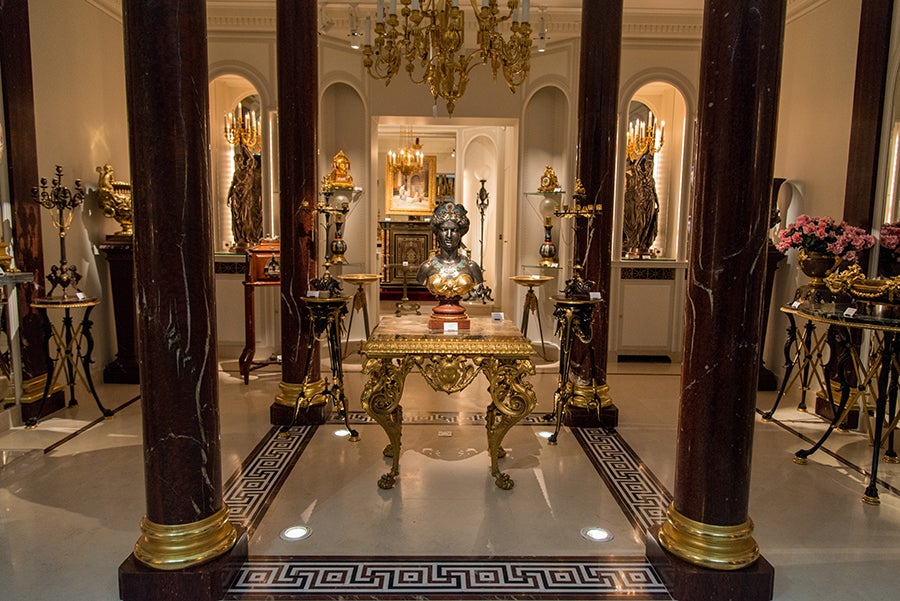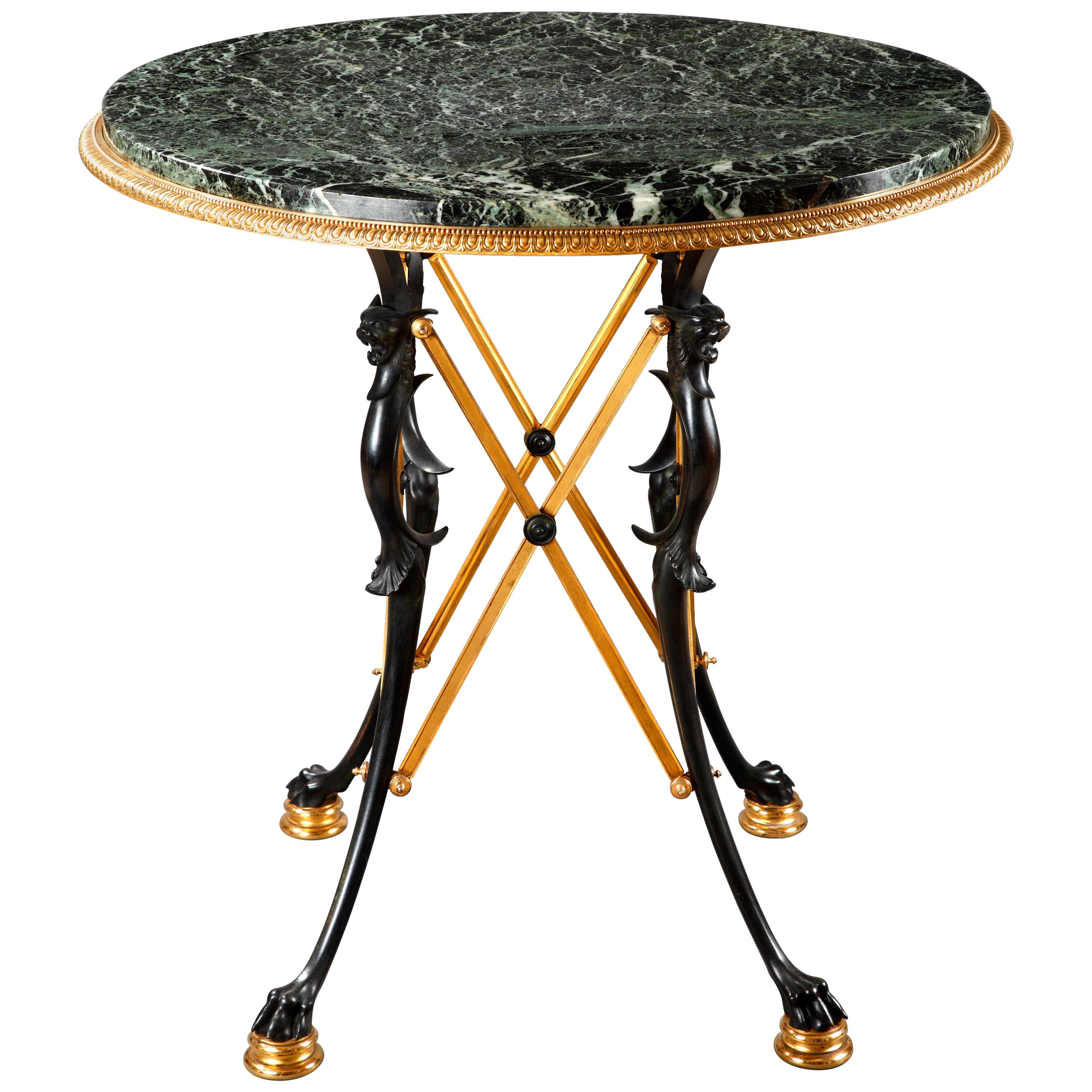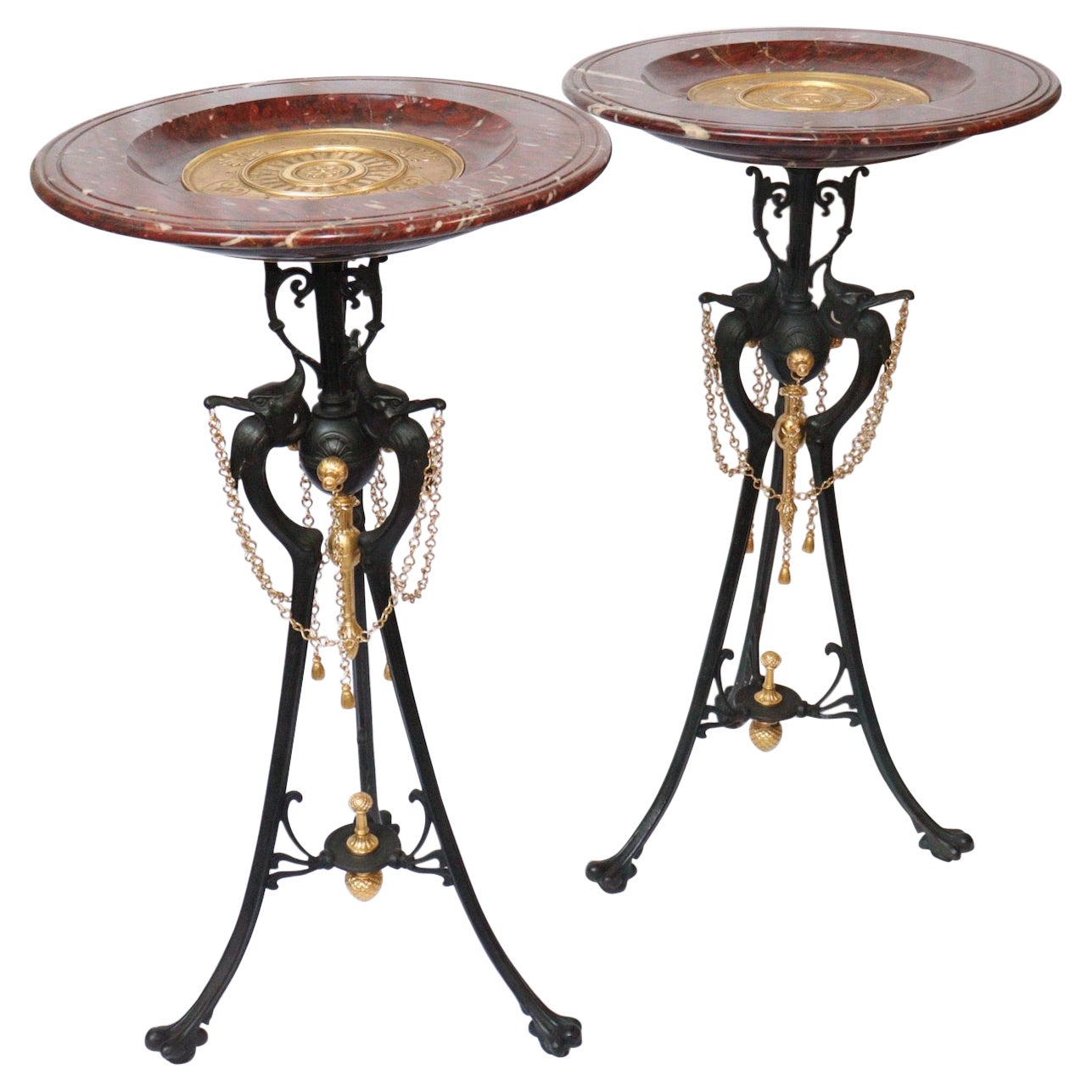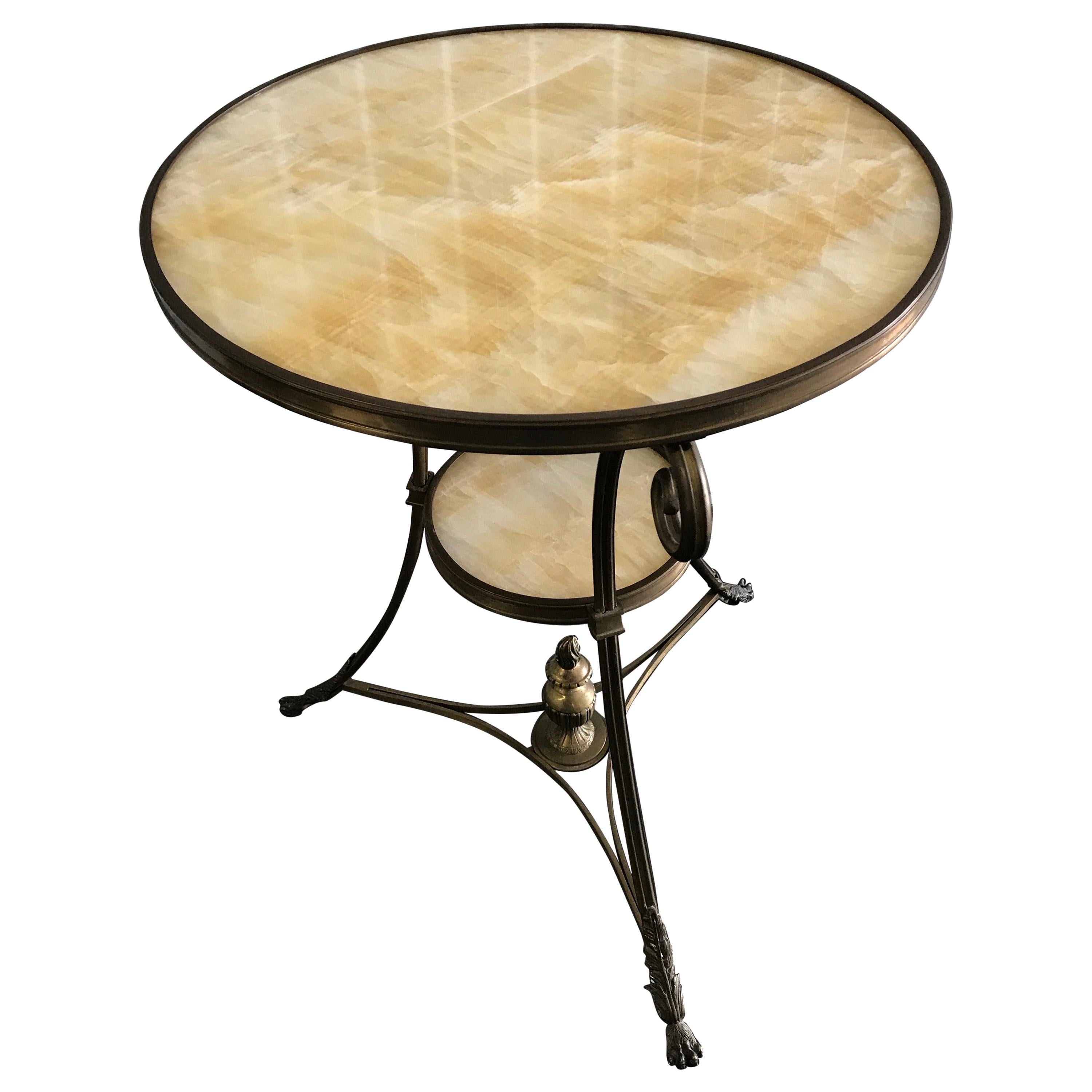Items Similar to Onyx and Bronze Neo-Greek Gueridon Att. to Barbedienne and Sevin, France, c.1880
Want more images or videos?
Request additional images or videos from the seller
1 of 9
Onyx and Bronze Neo-Greek Gueridon Att. to Barbedienne and Sevin, France, c.1880
About the Item
Gueridon made in silvered and gilded bronze, composed of four claw feet decorated with lion’s head held together by crossed bars in gilded bronze. It is surmounted by a large onyx top surrounded by a frieze of ovals and beads.
The feet of these gueridons adopt a sleek design and are adorned with claws and lion heads. This model is well known in the Barbedienne Company production and it has been reused many times by his workshop. This gueridon shows how the Barbedienne Company offered a range of furniture from the designs of its decorator Louis-Constant Sévin. He designed this model of gueridon few time after he joined the Barbedienne Company in 1855 and this model can be seen on different interior decorations of the Second Empire.
1/ A tripod gueridon, a little bit higher, with feet like these ones can be seen on a picture showing the atrium of the Pompeiian house built for Prince Napoleon. Most of the Ancient style furniture was made by Charles Rossigneux (1818-1908) but this gueridon shows that the Barbedienne Company took also part to this work.
2/ A picture of the Emperor’s study at Saint-Cloud Castle demonstrates that a gueridon of the same type took place in it ; it illustrates the success of this model in the imperial family.
Some years later the Gazette des Beaux-Arts published an engraving depicting a gueridon exhibited at the 1889 Universal Exhibition. The engraving shows a gilt bronze plate resting on a tripod having identical feet and it reveals the longevity of this model inside the Barbedienne Company production. The caption mentions “Bronze plate designed by Mr Levillain and made by Mr Barbedienne (1889 Universal Exhibition)”.
Louis-Constant Sévin (1821-1888) : he was first trained to design and sculpture with the sculptor Antoine-André Marneuf (1796-1865). In 1839 he went into partnership with two sculptors, Phénix and Joyau, and he created designs for famous goldsmiths such as Denière, Froment-Meurice and Morel. He fled to London during the 1848 Revolution where he worked at Morel, with whom he exhibited art works at the 1851 Universal Exhibition. Back to France he took part to the 1855 Universal Exhibition by creating designs to the Limoges porcelain makers Jouhanneaud and Dubois. Since then he worked as head decorator at Ferdinand Barbedienne’s Company. He produced a lot of works : he designed the bronze decoration for the Paiva’s Hotel (on the Champs-Elysées avenue) and created models for Ferdinand Barbedienne. He participated in different exhibitions and was awarded at the 1862 London Universal Exhibition for the artistical excellence of the furniture items he designed and which are exhibited by Barbedienne. He also received a Gold Medal as collaborator at the 1863 Central Union of Decorative Arts Exhibition.
Ferdinand Barbedienne (1810-1892) : he created and headed at n°30 boulevard Poissonnière in Paris one of the most famous 19th century artistic bronze casting companies. He owed his reputation to his bronze casting of Ancient and modern sculptures, which subjects came from the greatest European museums, but also to his original bronze works designed in his workshop and reserved for furniture and decoration. In addition to his own production, Barbedienne worked for renowned sculptors such as Barrias, Bosio, Clésinger or Carrier-Belleuse. Awarded with two Council Medals at the 1851 London Universal Exhibition, the Barbedienne Company won at the 1855 Paris Universal Exhibition a medal of honor and eleven cooperator's medals for the work of his co-workers, designers and chasers. The success of the Barbedienne Company at the diverse international exhibitions earned it several official commissions, as providing ornamental bronze for the Pompeiian house of Prince Napoleon, about 1860, avenue Montaigne in Paris. At the 1867 Universal Exhibition in his capacity as member of and speaker for the Jury, he was non-contestant, but exhibited nevertheless with great success cloisonné and champlevé enameled pieces. Barbedienne was made an Officer of the Légion d'Honneur in 1867 and Commander in 1878 when he was compared with “a prince of industry and the king of bronze casting”. His glory did not decline with the passage of the time for at the Universal Exhibition of 1889 the critics thanked Barbedienne for the example he set for other bronze-casters by the perfection of his bronzes.
- Attributed to:Ferdinand Barbedienne (Maker)Louis-Constant Sevin (Designer)
- Dimensions:Height: 30.32 in (77 cm)Diameter: 37.41 in (95 cm)
- Style:Greek Revival (In the Style Of)
- Materials and Techniques:
- Place of Origin:
- Period:
- Date of Manufacture:circa 1880
- Condition:Wear consistent with age and use.
- Seller Location:PARIS, FR
- Reference Number:1stDibs: LU3860328947682

About the Seller
4.9
Vetted Seller
These experienced sellers undergo a comprehensive evaluation by our team of in-house experts.
Established in 1997
1stDibs seller since 2018
73 sales on 1stDibs
Typical response time: <1 hour
Associations
International Confederation of Art and Antique Dealers' Associations
- ShippingRetrieving quote...Ships From: Saint Ouen, France
- Return PolicyA return for this item may be initiated within 7 days of delivery.
More From This SellerView All
- Pair of Neo-Greek Gueridons Attr. to L.C Sevin & F. Barbedienne, France, c. 1880By Louis-Constant Sevin, Ferdinand BarbedienneLocated in PARIS, FRPair of patinated and gilded bronze high guéridon attributed to L.C Sevin and F. Barbedienne, with for each of them, three paw feet joined by X shaped stretche...Category
Antique 1880s French Greek Revival Gueridon
MaterialsGriotte Marble, Bronze
- Neo-Greek Gueridon Attributed to F. Barbedienne, France, Circa 1880By Louis-Constant Sevin, Ferdinand BarbedienneLocated in PARIS, FRA similar model was exposed at the 1889 Paris Universal Exhibition ( see picture attached) Patinated and gilded bronze gueridon with four paw feet joined by X-shaped stems, attributed to Sévin and Barbedienne. Round green marble top mounted with a bronze rim adorned with oves and pearls motif. Born in 1821 and dead in Paris in 1888, Louis-Constant Sévin was apprenticed to the parisian sculptor Marneuf. In 1839, he joined the sculptor-modelors Phénix and Joyau, as designer, and designed silver-smith’s objects for famous firms like Denière, Froment-Meurice, Morel and Duponchel. During the Revolution in 1848, C. Sévin joined Morel in London, as workshop manager and designed pieces that Morel exhibited in 1851. Back in France in 1851, C. Sévin went to Limoges and designed models for the porcelain factories of Jouhanneaud and Dubois of which many pieces were exhibited at the Universal Exhibition in 1855. From this date on, he worked for Ferdinand Barbedienne as sculptor-ornemanist until the end of his life. Sévin’s works are considerable, he designed furniture bronzes for the « hôtel de La Païva ». At the London Exhibition in 1862, he was awarded a medal « pour l’excellence artistique des meubles qu’il a dessinés et qui sont exposés par Barbedienne » : for the artistic excellence of the furniture he designed and which is exhibited by F. Barbedienne. He won a second class medal at the Union centrale des Arts décoratifs Exhibition in 1863 and was awarded a gold medal as « cooperator ». F. Barbedienne said that posterity would remember Sévin’s compositions. The most extraordinary object designed by C. Sévin for F. Barbedienne, was a Renaissance style gilded bronze monumental clock...Category
Antique 1880s French Greek Revival Center Tables
MaterialsMarble, Bronze
- Neo-Renaissance Dining Room Set Att. to Barbedienne, Meynard & Sevin, circa 1890By Ferdinand Barbedienne, Louis-Constant SevinLocated in PARIS, FRDisplay sideboard : height : 285 cm (112 in.) ; width : 215 cm (84,6 in) ; depth : 70 cm (27,5 in.) Table (without extension) : height : 76 cm (29,9 in.) ; width : 170 cm (66,9 in.) ; depth : 120 cm (47,2 in.) / Extensions (x 2) : width : 45 cm (17,7 in.) ; depth : 120 cm (47,2 in.) Dresser : height : 180 cm (70,8 in.) ; width : 215 cm (84,6 in.) ; Depth : 65 cm (25,6 in.) Chairs : height : 114 cm (44,8 in.) ; width : 48 cm (18,9 in.) ; depth : 45 cm (17,7 in.) Woodwork attributed to Maison Meynard (1808-1889), Meynard Fils; ormolu mounting by Ferdinand Barbedienne (1810-1892) from drawing by Louis-Constant Sévin...Category
Antique 1870s French Renaissance Revival Furniture
MaterialsMarble, Bronze
- Neo-Pompeian Gueridon Attributed to F. Barbedienne, France, circa 1860By Ferdinand BarbedienneLocated in PARIS, FRA tripod gueridon in gilded bronze attributed to F. Barbedienne, decorated with palm-leaves and standing on lion’s feet. The black marble top is decorated with an antique chariot...Category
Antique 1860s French Gueridon
MaterialsMarble, Bronze
- Pair of Neo-Greek Wall-Lights Attributed to F. Barbedienne, France, Circa 1880By Ferdinand BarbedienneLocated in PARIS, FRA pair of neo-Greek wall-light sconces executed in two patina bronze attributed to F. Barbedienne. The central up-turned foliage stem, surmounted by a Greek style vase...Category
Antique 1880s French Greek Revival Wall Lights and Sconces
MaterialsBronze
- Pair of Neo-Greek Vase-Candlesticks Attr. to Barbedienne and Levillain, c. 1880By Ferdinand Levillain, Ferdinand BarbedienneLocated in PARIS, FRPair of Greek style amphora shaped candlesticks made of gilded and patinated bronze attributed to F. Levillain and F. Barbedienne. Each flanked with two handles, and decorated with horsemen in relief. Standing on three lion’s feet headed with busts of putti and raised on a red griotte marble base. Ferdinand Levillain (Paris, 1837-1905) studied under the sculptor Jouffroy (1806-1882), before making his debut in 1861 at the French Artists Salon where he continued to exhibit until 1903. At the 1867 Universal Exhibition in Paris, he was praised for a Neo-Greek style bronze cup he made for the firm Blot and Drouard. He was not to become really famous, however, until 1871 thanks to his association with the great bronze founder Ferdinand Barbedienne, who began to exhibit Neo-Greek style lamps...Category
Antique 1880s French Greek Revival Table Lamps
MaterialsBronze
You May Also Like
- Neoclassical Style Gilt-Bronze Gueridon Attributed to Ferdinand BarbedienneBy Ferdinand BarbedienneLocated in Brighton, West SussexAn unusual neoclassical style gilt bronze Gueridon with an inlaid black marble top, in the manner of Ferdinand Barbedienne and Louis-Constant Sévin. This unusual Gueridon has a ci...Category
Antique 1860s French Neoclassical Revival Gueridon
MaterialsBelgian Black Marble
- 19th Century Pair of Neo Greek Sellettes en AthéniennesBy Ferdinand BarbedienneLocated in Saint-Ouen, FRA French 19th century very unusual and decorative pair of neo greek gilt and patinated cast iron sellettes en athéniennes With red griotte marble bassin...Category
Antique 1870s French Greek Revival Pedestals
MaterialsGriotte Marble, Metal, Ormolu
- Directoire Style Onyx and Bronze GuéridonLocated in West Palm Beach, FLStunning onyx and bronze Directoire style guéridon with paw feet. Lower onyx shelf and central finial.Category
20th Century Directoire Gueridon
MaterialsOnyx, Bronze
- Patinated and Dore Bronze Empire/Neo-Grec French Side Table, Att. F. BarbedienneBy Ferdinand BarbedienneLocated in New York, NYA Beautifully Designed Small Patinated and Dore Bronze French Side Table, Attributed to F. Barbedienne, the Magnificent French Metalworker and Manufacturer. This beautifully cast an...Category
Antique 1880s French Empire Side Tables
MaterialsMarble, Bronze
- Two 19th Century Gilt Bronze and Marble Round Tables by BarbedienneBy Ferdinand BarbedienneLocated in London, GBThese beautiful and unusual round tables (or guéridons) were crafted by the leading bronze manufacturer of the French Belle Époque, the Barbedienne foundry. Established in 1838, the ...Category
Antique Late 19th Century French Neoclassical Gueridon
MaterialsMarble, Bronze, Ormolu
- Pair of French Neo Classic GueridonLocated in Saint-Ouen, FRFrench neo classic gueridon x2Category
Mid-20th Century French Gueridon
MaterialsWood
Recently Viewed
View AllMore Ways To Browse
Hotel Bar Table
Antique Dining Tables London
Antique Dining Table London
Oval C Table
French Table Onyx
Antique Medal Table
Bronze Claw Feet
Tripod Bronze Table
Modern Dining Table On Casters
Work Table Casters
Antique Onyx Table
King Louis Table
French Claw Table
Ancient Greek Table
Lions Head Dining Table
French Modern Gilded Table
Bronze Oval Dining Table
Work Table With Casters





